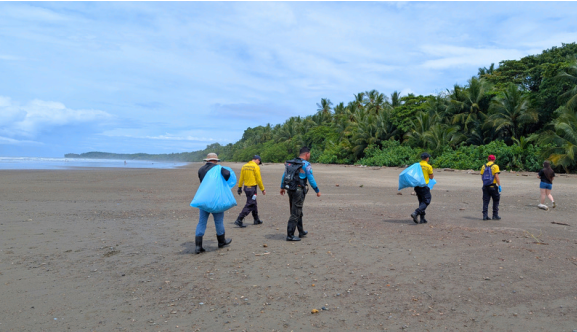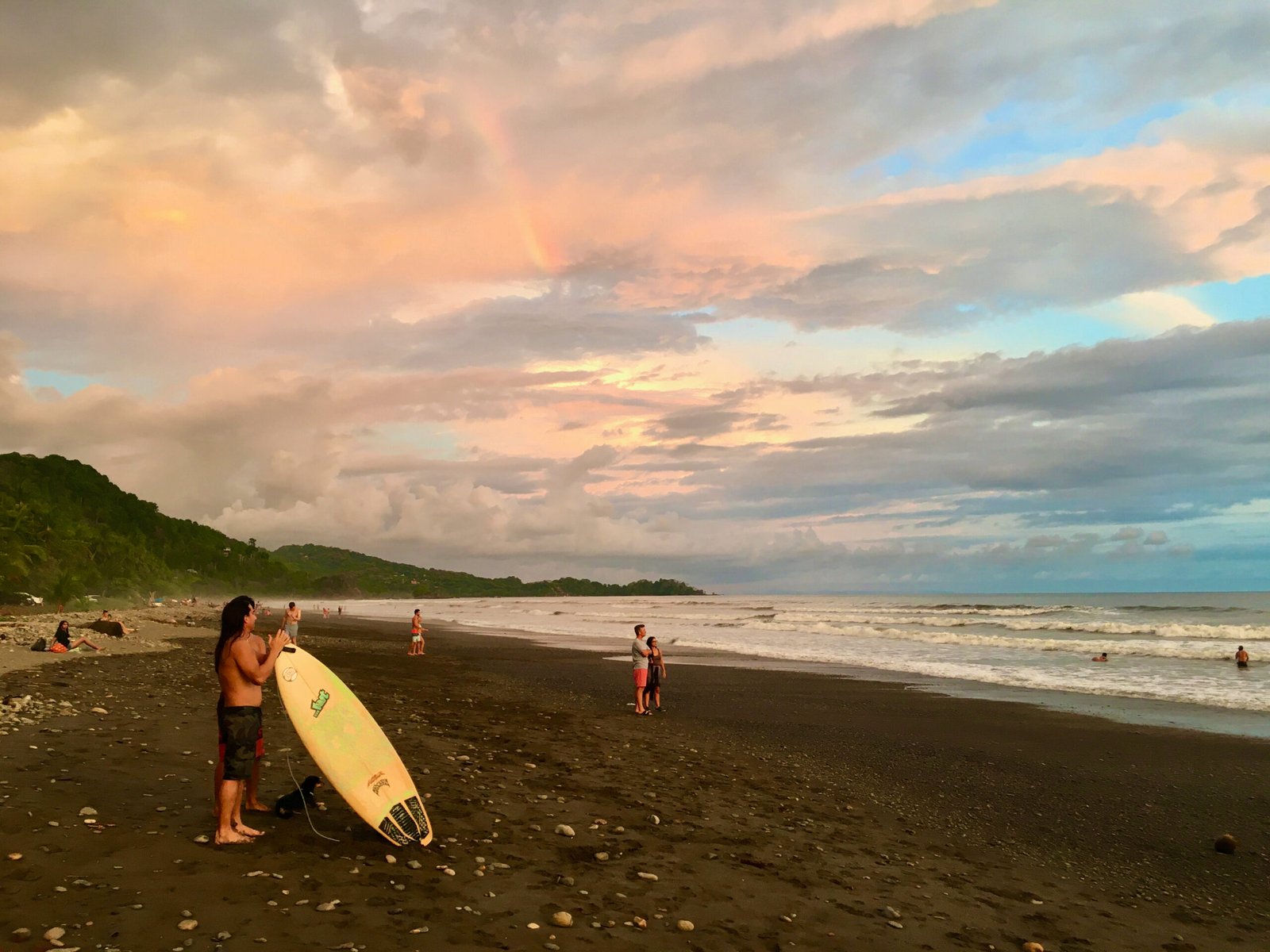How Do We Get To Boruca?

Entrance to Boruca town by Dagmar Reinhard
Throughout the year, but especially in December, there are many events and festivals in the village of Boruca. The directions below will take you straight to this beautiful village where you can experience a world of art, culture, and history.
From San José, take the highway known as Autopista del Sol Route 27, exit Tárcoles - Jaco. Follow Highway 34 to Dominical and from there continue driving down the Coastal Highway to Palmar Sur, about one hour and 15 minutes.
When you reach the junction with Palmar, turn left, taking the Pan-American Highway toward Buenos Aires. After approximately 25km, you will see a sign on you left hand side indicating the town of Boruca.
It is a slightly steep road and requires a 4x4 vehicle. The uphill road is approximately 8km, and it offers a spectacular unobstructed view of the two valleys on either side; you will also admire the Térraba River and the Cordillera on the horizon. Nearest airport: Palmar Sur.
Read more information on Indigenous Culture:
Indigenous Culture in Costa Rica
Busting Myths About Costa Rica Destination, Free Costa Rica Magazine #99
Busting Myths About Our Destination, Free Costa Rica Magazine #99
.Dear community, advertisers, and contributors,
It is a pleasure to present our 99th digital edition, a space dedicated to celebrating the beauty, experiences, and stories that make Costa Rica’s South Pacific a unique destination.
Whether this paradise is your home or you are planning a visit, our mission is to inspire and inform you with content that deeply connects with the essence of this region.
A call to action for the environment
In this edition, we highlight events that reflect our community’s commitment to conservation. CleanUp 2025 was a resounding success, bringing together passionate volunteers to clean the beaches of the Ballena Marine Park. Sophie, one of our volunteers, shares her experience in an inspiring article, reminding us of the importance of protecting this natural environment.
Celebrating marine life
Another unmissable event is the Whale and Dolphin Festival, a celebration that brings us closer to the majesty of these marine creatures. This festival is not only an opportunity to enjoy nature, but also to learn about the biodiversity that makes this region unique.

Exploring Caño Island
For those seeking unforgettable adventures, our volunteer offers a captivating account of her visit to Caño Island. This magical destination promises fascinating underwater landscapes and a special connection with the natural environment. Don’t miss it!
Surfing and Adrenaline in the Green Season
Surf lovers will find their personal paradise in the South Pacific. Greg Gordon explains why this region shines as an ideal destination for practicing this sport, especially during the “green season.” From perfect waves to a relaxed atmosphere, this place has everything a surfer could wish for.

Taking Care of Your Well-Being
In terms of health, the Vargas Medical Center offers valuable advice on how to respond to an emergency in Uvita. Additionally, Dr. Mónica Alfaro introduces us to the world of facial harmonization and comprehensive rejuvenation, services available at Bahía Ballena Doctors for those seeking to take care of their physical and emotional well-being.
Unmissable Opportunities and Professional Advice
If you’re looking to renovate your space, the RECHERCHE store is clearing its inventory with discounts of up to 90%. It’s an opportunity you won’t want to pass up. Architect José Guillén, executive director of ARTESANO, provides key information on construction contract guarantees, emphasizing the importance of adhering to written agreements and ethical principles in architectural projects.

Busting Myths About Our Destination
We’ve recently seen misinformation circulating suggesting that the South Pacific is an expensive destination for visitors. In this issue, we include an article debunking these claims and invite you to share it on social media. Together, we can spread the truth about how accessible and memorable this region is.
The Magic of the Rainy Season
If you haven’t yet experienced the rainy season in the South Pacific, we cordially invite you to. From lush landscapes to unique adventures, this time of year offers an unforgettable experience. We always remind everyone, visitors and residents alike, to minimize their environmental impact and responsibly care for this beautiful region.
Thank you for being part of this vibrant community and for joining us for each issue. We hope you enjoy the articles we’ve lovingly prepared and that you continue to explore all that this corner of the world has to offer.
¡Pura Vida!
The Editorial Team
Ballena Tales is an essential free digital magazine and travel guide in Costa Rica, valid for travelers, residents, and investors covering Costa Ballena in the Canton of Osa in the South Pacific of Costa Rica. It is a fully bilingual, bi-monthly, and full-color digital magazine.
The magazine introduces the reader to the life of the local community, with interviews of pioneers, writers, and artists, as well as extensive information on restaurants, hotels, experiences, natural attractions, and wildlife of the Costa Rica South Pacific.
We are not just a magazine; each edition (print and digital) is linked to a robust web platform; the editions are published online, and the advertorials are included in our blog and the brand in the commercial directory. We also add links to the advertising company’s website and social networks. At this time, the openings of digital publications in all their expressions exceed 80 thousand openings, and the advertised brands have a global reach.
We have a loyal audience of over 8,000 readers in the South Pacific’s Costa Ballena region who will view your news in each printed edition.
We prioritize our readers’ satisfaction by delivering a variety of engaging content while showcasing the value of our advertisers’ brands.
What to do, Where to eat, and Where to stay…
- Activities and Tours
- Whale Watching Tour
- Natural Attractions
- Marino Ballena National Park
- Restaurants
- Hotels and Accommodations
South Pacific Costa Rica Beaches,
Looking for business directories, maps or other printouts? We’ve got that too!
Dare to Discover and Enjoy…
Check out…
Need help planning your next trip? Let us help you with your Costa Rica vacations!
Email: carlos@ballenatales.com
Phone: +(506) 8946 7134
Christophe Gstalder: Boruca – A Vanishing Race and Culture
Christophe Gstalder photographer, Boruca – A Vanishing Race and Culture

“The most beautiful landscape of the Boruca community is the humbleness of its people”
I have never worked in my life! (Christophe´s passion for photography, does not allow him to call it work). He is originally from Marseille, France; he grew up traveling across the world with his father.
- [singlepic id=140 w=320 h=240 float=right]
20 years ago, he began working on his film “Los Diablitos – Por Encima De Las Nubes” (The Little Devils – Above the Clouds), a documentary about the Boruca Culture, their Traditions & People. The Film´s original soundtrack is directed by Christophe and Guillain Joncheray (Deep Forest.) Christophe´s sensibility, his respect for the ancient culture, and the beauty he sees in the Indigenous world through his camera, helped him to give birth to an incredibly beautiful 52-minutes documentary. “I did not expect anything different; it’s a true 100 % self-made film, during a long journey, without deadlines, with no producer demands, free as a bird, in a length that brings maturity of feelings …” he told us.
“I miss Costa Rica and my dear friends, anchored in my thoughts and heart. My mission in life is to complete this film. (If SIBU wants it… I think so! SIBU wants it!)
Christophe Gstalder is a notorious free-lance photographer for Fashion Magazines such as Marie-Claire, Elle, Vogue, Cosmopolitan, and he recently visited Zanzibar (East Africa).
Christophe Gstalder photographer Facebook Page
LOS DIABLITOS Au dessus des nuages Bande Annonce
The Boruca Little Devils’ Game

By Cristhian González Gómez
The Boruca Little Devils’Gam is a ceremony, which takes place between December 30 and January 2, originally named Cagbrúˇ rójc (1) in Brunca language, and known as “The little devils’ game” outside of Boruca Territory, is about the struggle of native Borucas against the Europeans (Síˇcua rójc) during colonial times. In a dramatic way, and with processions or walks around the community where the characters wear masks, people reenact the violent encounters between the Borucas and the Spanish invaders, represented by a mock bull (Samán) (2) . For the Borucas, these dates are highly expected, since they consider this celebration one of their most representative ancient cultural expressions.
Its importance brings together both native Costa Rican indigenous people and non-indigenous citizens, besides other visitors from abroad. This is how they reinforce their pride for their identity, and their motivation to protect the legacy that their ancestors have trusted us with. It’s fundamental to take into account that, every day, the Indigenous Peoples clash with transculturation and adversities that endanger their traditions.
Regarding their economy, the Boruca Little Devils’Gam allows various organized and touristic groups to interact, and they have a very positive participation in the community’s progress. Boruca artists embellish this activity with their masks and costumes, and prepare the staging for the walks around the area. The preparations for this party begin several months before.
During the three days, Boruca creates an environment of cultural enjoyment, family coexistence, and a warm welcome for tourists, surrounded by traditional music and a pleasant atmosphere
(1) “Diablitos”in English (2) “Toro” in English
Boruca Gallery Gift Shop
Boruca Gallery Gift Shop

~ by Susie Atkinson
Looking for a unique souvenir of your trip to Costa Rica – something that is a true representation of the local folklore and does not have that “Made in China” stamp on it?
Look no further; Boruca Gallery Gift Shop has handcrafted products that were made by the Borucans, our local indigenous.
 The Borucans are the only tribe of Costa Rica that was not conquered by the Spanish conquistadors in the late 1400s-early 1500s.
The Borucans are the only tribe of Costa Rica that was not conquered by the Spanish conquistadors in the late 1400s-early 1500s.
They defended themselves in a unique way: by carving and wearing very scary masks in the form of the face of a devil, which chased the Spaniards away; thus, becoming known as the "diablitos" (little devils).
The Gallery has a wide collection of the best detailed carved masks/wall hangings, as well as hand-woven, naturally dyed 100% cotton products, such as placemats, table runners, tote bags, and yoga mat carriers.
Each year, our shop has grown.
In 2016, we increased our sales of the carved masks by 30% in just the first 11 months of 2016; 330 masks were sold. Our woven sales of 260 pieces
remained about the same as last year.
Our store wants as many sales as possible to keep the money flow going into the Borucan village, since 80% of their income comes from their handcrafted products.
Therefore, our prices have a very little markup.
Our stock is changing constantly. At any given time, there are 25 - 40 unique masks ranging in price from $10 to $125, along with all the woven goods.
Tourists love learning the history about the masks and weavings, knowing they are getting an authentic souvenir from their visit to Costa Rica.
Please stop by The Gallery or make a day trip to the village and learn about our indigenous folklore artwork!
INFO: Susie Atkinson – pacificedgedominical@gmail.com
Milking of the Murex snail at Ventanas Beach
Milking of the Murex snail

By Susie Atkinson and Ellen Hoel
The art of milking the Murex snail dates back to the 4th century B.C.
Cleopatra used that procedure to dye the sails of her boat purple with the intent of flattering Caesar. The gathering of those fluids is a tradition that has been passed down from generation to generation. The Murex snail discharges a milky-white secretion that changes color when exposed to air and light. This transformation begins with a shade of yellow, followed by a pastel green. Finally, under direct sunlight, it turns into a lovely shade of purple, also known as imperial purple.

The women of Boruca use this unique extract to dye the cotton yarn they will use in their weaving. During the waning moon, the Borucans make a memorable trip to the rockiest part of Ventanas beach in Costa Ballena in January and February, knowing that they will find the Murex snails hiding and mating along the rocks.

It is a dangerous and treacherous work to find and "milk" the snails. Doña Marina and others pull the snails off the slippery rocks at Ventanas beach. They proceed to blow on them very carefully to cause the snails to release the fluid, letting it drip over the yarn they are holding. This fluid cannot be stored; therefore, the yarn has to be dyed on site.
The Borucans are one of two indigenous groups remaining in the world that use this process. They preserve the life of these snails by returning them to the rocks after taking the fluid.
Doña Marina goes to the Farmers' Market in Uvita almost every Saturday morning. Her weavings and carved masks are also available at Pacific Edge Cabins in Dominicalito.
Ballena Tales is an essential free digital magazine in Costa Rica, valid for travelers, residents, and investors covering Costa Ballena in the Canton of Osa in the South Pacific of Costa Rica. It is a fully bilingual, bi-monthly, and full-color digital magazine.
The magazine introduces the reader to the life of the local community, with interviews of pioneers, writers, and artists, as well as extensive information on restaurants, hotels, experiences, natural attractions, and wildlife of the South Pacific of Costa Rica.
We are not just a magazine; each edition (print and digital) is linked to a robust web platform; the editions are published online, and the advertorials are included in our blog and the brand in the commercial directory. We also add links to the advertising company's website and social networks. At this time, the openings of digital publications in all their expressions exceed 80 thousand openings, and the advertised brands have a global reach.
We have a loyal audience of over 8,000 readers in the South Pacific's Costa Ballena region who will view your news in each printed edition.
We prioritize our readers' satisfaction by delivering a variety of engaging content while showcasing the value of our advertisers' brands.
What to do, Where to eat, and Where to stay…
- Activities and Tours
- Whale Watching Tour
- Natural Attractions
- Marino Ballena National Park
- Restaurants
- Hotels and Accommodations
South Pacific Costa Rica Beaches,
Looking for business directories, maps or other printouts? We’ve got that too!
Dare to Discover and Enjoy…
Check out…
Need help planning your next trip? Let us help you with your Costa Rica vacations!
Email: carlos@ballenatales.com
Phone: +(506) 8946 7134



















